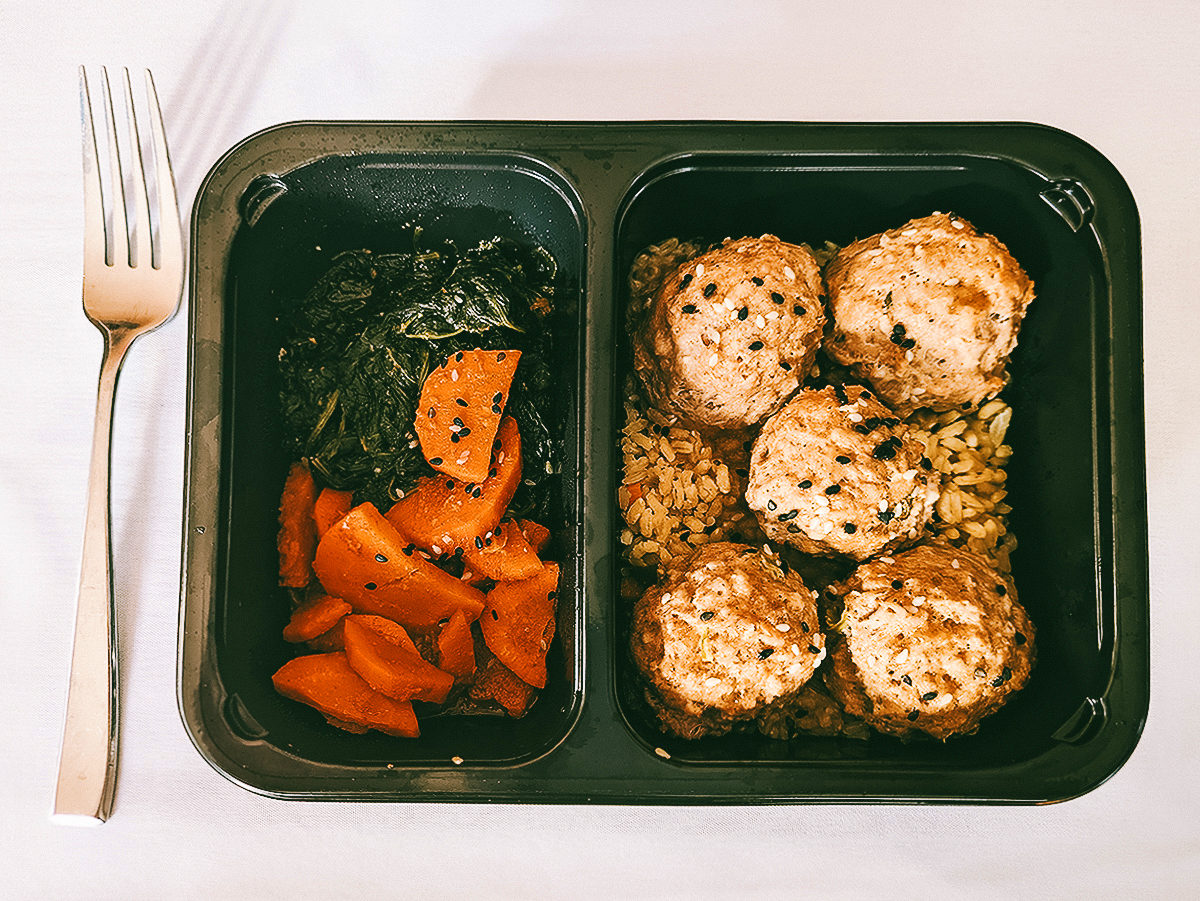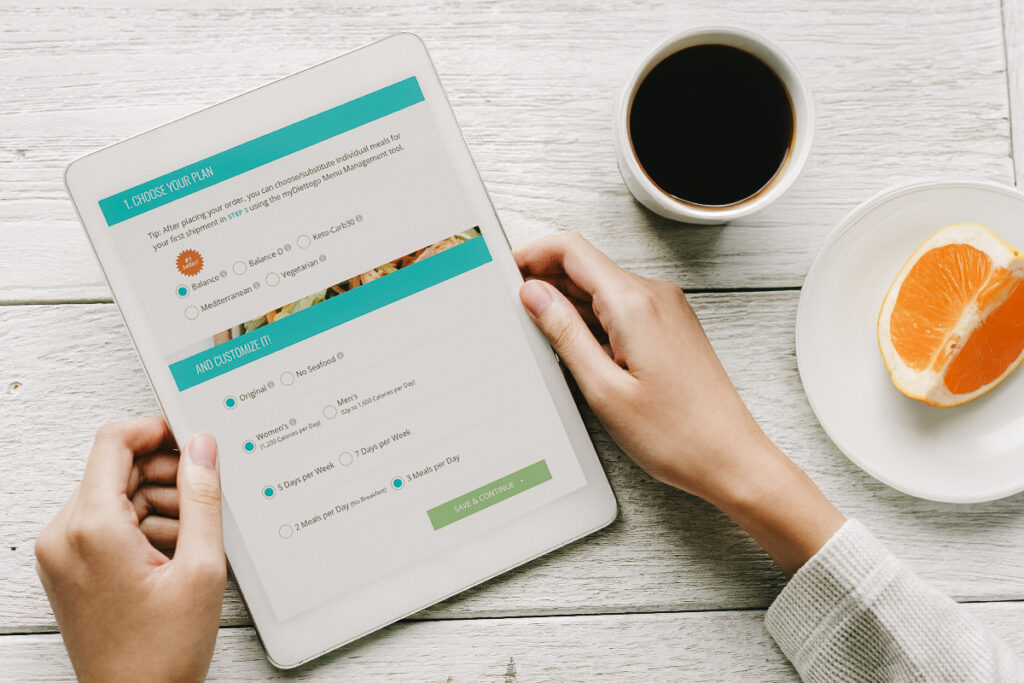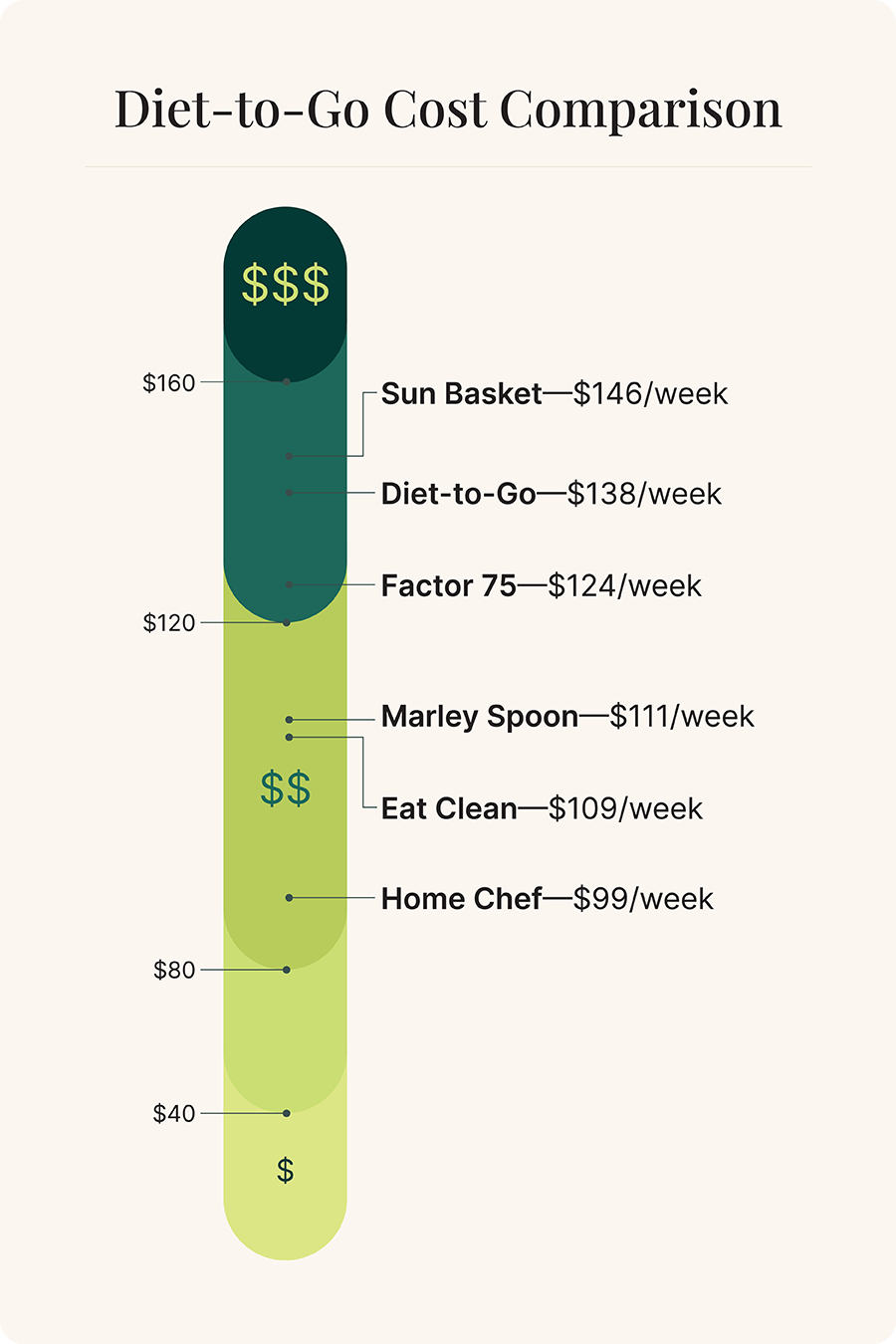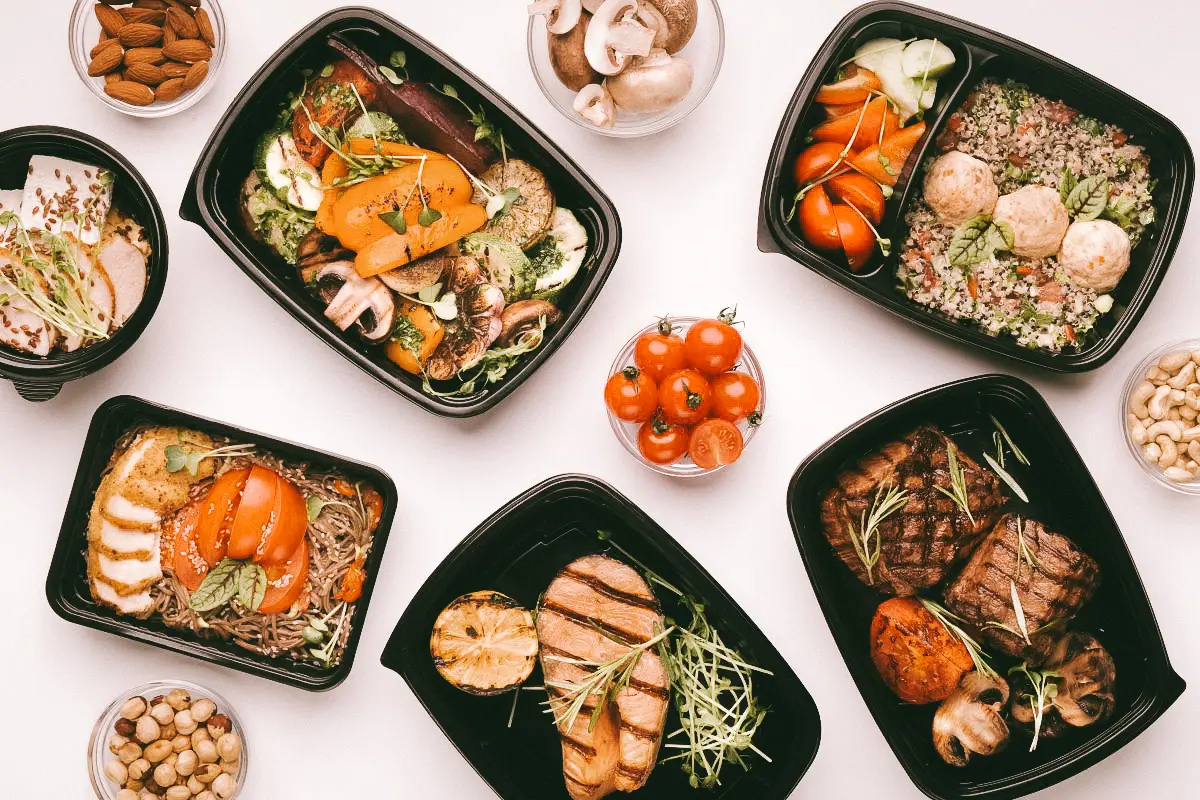Table of Contents
- Diet-to-Go is a meal delivery service with customizable meal plans that are shipped fresh or frozen, depending on where you live.
- Meals are pre-portioned, with multiple plans for specific health needs and preferences.
- Depending on your chosen plan, prices range from $138.99–$225.99 per week.
- Plan meals have set calorie levels based on gender, which may not work for everyone.
- Diet-to-Go offers coaching with registered nutrition experts by email and phone.
In a market saturated with fad diets and services that only seem to promote weight cycling, it can be hard to know where to start when embarking on a weight loss journey. But you’re not alone. Millions of people work to lose weight every year. In fact, nearly one-third of U.S. adults said they were concerned about obesity, according to a 2021 survey. That means millions of people can relate to the stress, frustrations, and mental challenges you might be feeling right now.
Research shows that the relationship between what we eat and how we feel is closely related. Anxiety, depression, and stress can affect your metabolism, which can cause unwanted weight gain and worsen mental health issues. We also know weight loss can be demanding and time-consuming—few of us have the time or energy to hit the gym after a long workday and cook three healthy meals a day. Weight loss can be mentally and physically taxing, but taking the first step to decide to make a change is often the hardest part.
The good news is weight loss doesn’t have to involve a restrictive diet, extreme gym routine, or lengthy grocery store trips. Meal delivery services can be a valuable option if you want quick and easy calorie- or portion-controlled meals for weight loss. One option, Diet-to-Go, provides a variety of pre-packaged meals that are delivered right to your front door.
Read on for our in-depth review of Diet-to-Go, and find out if it could be a sustainable weight loss solution for you.
Why Helpguide cares about healthy eating
Healthy living, including a balanced diet, is directly related to your mental health and overall health. Eating a healthy, well-balanced diet can help reduce symptoms of depression, reduce your risk of chronic diseases, like heart disease or type 2 diabetes, and strengthen your bones and muscles.
We understand that weight loss can be a difficult subject. It’s often fraught with negative emotions that can directly impact your healthy living journey. Research shows that feelings of shame, self-criticism, and social comparison can make it difficult to manage your weight and regulate your eating habits. Some weight loss programs can even exacerbate these feelings. Our Handbook Team is here to offer our guidance and to help you find weight loss platforms that are supportive, positive, and fun to use.
The relationship between weight loss and mental health is often overlooked. For some, weight loss can bring positive experiences of confidence and accomplishment. For others, weight loss can lead to feelings of anxiety, despair, and hopelessness. It is important to consider how your mental health can be affected as you embark on a weight loss journey.
Karin Evans, registered dietitian nutritionist at Top Nutrition Coaching
There are considerable mental health benefits associated with healthy eating. But we know that with so many weight loss programs out there, it can be hard to know which one to choose. That’s why we’ve made it our mission to share the best information about the tools available. We’re invested in helping you find a weight loss plan that’s safe, encouraging, and supportive.
Through hands-on testing, interviews, surveys, and insights from healthy eating experts, we’ve formulated a strongly informed perspective that we’re sharing with you here.
If you’re affected by an eating disorder or experience patterns of disordered eating, we suggest talking to a dietitian, therapist, or counselor who specializes in eating disorders before you enroll in any weight loss program.
HelpGuide Handbook for Diet-to-Go
Here are four important things to know about Diet-to-Go.
Our testing experience
Our Handbook Team spent two weeks subscribed to one Diet-to-Go plan. During that time, we became familiar with the website and social media communities. When mystery shopping, we found the website user-friendly, and we signed up with ease.
After researching a variety of plans for specific health needs and preferences, we selected the Balance plan, the 1,200 calories per day option. The Balance menu offers heart-healthy, low-carb, low-fat, and low-cholesterol options, according to Diet-to-Go. You can review a sample of the Balance menu, or any other menu, on the brand’s website.
Once we selected our preferred plan, Diet-to-Go pre-selected our weekly meals, but you can easily swap them out for other meals if needed. Our order arrived early the following day, and the meals were frozen as promised. The directions instructed members to put all the frozen meals in the refrigerator, and most were thawed and ready to eat the next day.
From our tester
“Selecting meals was very easy to do on the website. The Balance menu had a wide variety of dishes from different cuisines to choose from, and I was able to swap out meals that didn’t appeal to me for ones that did.”
As with all calorie-restricted meal plans, we focused on each plan’s food quality and how practical each plan was for daily use. An important part of any weight loss program is determining how easy it is to maintain for the long term, and not all plans are realistic or provide enough nutrition to get you through the day.
The conclusions we’re sharing with you here are a compilation of our testing results, interviews and surveys with platform users and focus group members, and insights from health experts.
Learn more about our healthy living review methodology.
Pros and cons of Diet-to-Go
As with most weight loss programs, there are pros and cons, and Diet-to-Go may not be the right fit for you. Here are the high and low points from our testing process.
What we like:
- Quick delivery.
- Food is pre-portioned.
- Easy to switch meal selections.
- Helpful coaching and a welcoming community.
- The company is receptive to customer feedback.
What we don’t like:
- The diet analysis is based on BMI.
- The plan could be more inclusive of dietary needs.
- Meals must be defrosted in the refrigerator before eating.
- No smartphone app.
- Expensive.
Pros
Overall, we liked that Diet-to-Go is simple and time-efficient. After storing or defrosting in the refrigerator, the pre-packaged meals can be heated in the microwave in minutes, which is great for someone who doesn’t have the time or energy to grocery shop, meal prep, or cook every day.
We also appreciated that Diet-to-Go offers coaching with registered nutrition experts, so you can receive concrete advice about safe weight loss and exercise goals. This also provided an opportunity for us to ask clarifying questions about our nutrition meal plan. Our tester was able to interact with a registered dietitian via email and by phone.
From our tester
“Coaching with a registered dietitian gave me the confidence to safely make changes to the way I eat. Her recommendations were reasonable, and I can incorporate her tips into my day-to-day life.”
Cons
While we appreciated the ease of delivery, we didn’t like that Diet-to-Go lacks personalization. Many factors, like age, gender, hormones, metabolism, and genetics, can impact a person’s ability to lose weight. Diet-to-Go did not take these factors into consideration.
We talked with Lena Bakovic, director of malnutrition quality and the regional clinical nutrition manager at Morrison Healthcare in Palm Beach County, Florida, who was concerned the program doesn’t offer a more personalized approach.
“The set caloric levels of these prepared meals based on gender may not be a one-size-fits-all solution,” Bakovic says. “For long-term sustainable weight loss, it is important to ensure we are consuming enough calories to fuel our metabolism, as well as containing the right balance of macronutrients—carbohydrates, proteins, and fats. Otherwise, we can end up feeling deprived, hungry, and then it doesn’t end up being bearable for the long term.”
One focus group member noted that hunger can become a problem when you’re not getting enough calories during the day. “I also lost sleep because I would be so hungry that I couldn’t fall asleep at night,” she said.
There were also instances when it seemed like certain meals did not align with standard nutrition guidelines. The Diet-to-Go website states that its meals are heart-healthy and limit sodium, carbs, fat, and cholesterol, but we found this isn’t always true. For instance, the herb-crusted tilapia contains 890 milligrams of sodium, which is more than half of what people watching their sodium intake should have in a day, according to the American Heart Association (AHA). The AHA recommends aiming for no more than 2,300 milligrams of sodium per day and an ideal limit of no more than 1,500 milligrams per day for most adults watching their sodium intake. Recommending a dish that essentially wipes out your sodium intake for the day seems counterintuitive.
Another downside of Diet-to-Go is that the program determines user weight loss expectations on a few specific biometric pieces of data, which calculates one’s body mass index (BMI) score. While BMI is one metric that health care providers use to assess underweight, healthy weight, overweight, and obesity, your BMI does not distinguish lean muscle from fat mass and can be misleading as a health metric.
I feel like every time that I’m trying to actively lose weight, I automatically feel restricted, even if the program itself aims not to be.
Focus Group Participant
How does Diet-to-Go work?
Diet-to-Go provides an online service for you to select meals that are suitable for weight loss. The program is built around cutting calories to lose weight. Research shows that restricting calories can lead to significant weight loss and that the safest way to maintain a calorie deficit is by taking your time and aiming to lose no more than 1 pound per week. While Diet-to-Go is likely to prompt weight loss, the program lacks guidance on how to sustain your weight loss in the long term or how to maintain your weight once you stop the service.
Here are the steps you’ll take once you sign up for the service:
- Choose your plan: You can select from five options—Balance, Balance-Diabetes, Keto-Carb30, Mediterranean, and Vegetarian.
- Customize your plan: You can select the number of meals you want to receive each week. I chose three meals per day for five days.
- Enter your personal details: Include your delivery address and credit card information.
- Choose meals: Diet-to-Go pre-selects meals for you, but you can swap them at no additional cost. To make changes to the following week, you must make updates to your plan by noon (EST) each Friday.
- Cook meals: After defrosting meals in the refrigerator, you can cook them in a microwave or oven.
Diet-to-Go meals
Our tester tried three meals per day for five days. Here is a breakdown of what our tester ate in a day and how the meals tasted.
Breakfast: Waffles with blueberry cream cheese and peaches
The waffles looked like frozen waffles one could get at any grocery store. Our tester chose to cook them in a toaster oven rather than a microwave to ensure the waffle was crispy. We found the waffle flavor bland, and the blueberry cream cheese was not tasty. The peaches, though, were fresh and were a nice pairing to the waffle.
Lunch: Asian meatballs with brown rice, sesame spinach, and carrots
The meatballs were delicious and had a nice kick of spice, but the rice and vegetables were unseasoned. The instructions recommended microwaving the dish, but we suggest heating the vegetables in a saute pan to improve the texture.

Dinner: Salmon over cauliflower and spinach puree with a side of Brussels sprouts
The salmon was the star of this dish, but the Brussels sprouts were soggy. Cooking the vegetables in an air fryer or roasting them in the oven would be better and worth the time. The cauliflower and spinach puree was bland and needed a little garlic powder to add flavor. Overall, we found many of the dishes lacked seasoning, and microwaving the meals was the worst cooking method, though that is what was recommended.
The Diet-to-Go plan also came with snack recommendations for in-between mealtimes, including savory and sweet options. Our tester didn’t find these snack options appetizing or filling. For instance, one snack recommendation was simply a teaspoon of peanut butter.
Here are some of Diet-to-Go’s snack recommendations:
Savory snacks:
- A large hard-boiled egg.
- 1 teaspoon of peanut butter.
- 10 Kalamata olives.
- 14 whole raw almonds or pistachios.
- A sliced cucumber with 2 tablespoons of hummus.
Sweet snacks:
- A Mandarin orange.
- Half a cup of blueberries.
- 1 cup of strawberries.
- Sugar-free pudding or Jell-O snack cup.
- Half a cup of blueberries or raspberries.
Meal plan options
Diet-to-Go offers plans for different types of health needs and preferences.
- Balance: Offers a large selection of meals. You can opt to include or exclude seafood.
- Balance-Diabetes: For people with type 2 diabetes who want to lose weight and control their blood sugar through fat- and carbohydrate-specific meals.
- Keto-Carb30: A low-carb, high-fat meal plan.
- Vegetarian: Mostly plant-based but includes dairy and egg products.
- Mediterranean: Includes whole foods, such as fruits and vegetables, nuts, beans, grains, fish, and lean meats.

Nutrition by percentage
| Plan | Protein % | Fat % | Carbs % |
|---|---|---|---|
| Balance | 20 | 32 | 48 |
| CARB30 | 38 | 50 | 11 |
| Balance-Diabetes | 28 | 32 | 4 |
Diet-to-Go coaching and community support
We met with a registered dietitian (RD) to discuss our weight loss and fitness goals. We found the RD gave reasonable advice like aiming to lose 1 pound, but no more, per week. They also recommended making exercise, not just dieting, a priority. The RD also helped us calculate how much water we should drink each day based on our current weight and level of physical activity.
Not everyone will stay subscribed to the program long-term. The RD recommended that we keep the Diet-to-Go containers to help with portion control for when we stop using the program and start cooking our own meals again, which we thought was a neat strategy.
The Diet-to-Go Facebook community was also positive. Members are encouraged to foster community and find accountability partners, so you have an ally to openly share wins or frustrations with. One concern we had was when members announced they were losing more than 1 pound per week. That might not be safe or realistic for many individuals, so try not to compare your own weight loss progress to other people’s progress.
Throughout the testing experience, community support was one of the most positive aspects of Diet-to-Go. It can be a powerful way to stay motivated and find accountability as you change your eating habits significantly.
How much does Diet-to-Go cost?
Depending on the meal plan and frequency you choose, Diet-to-Go cost ranges from $138.99–$225.99 per week. Shipping costs are an additional $19.98 per order. Discounts are available to students, teachers, first responders, government employees, medical providers, military staff, and people age 55 and up.
Diet-to-Go accepts credit card payments and provides instructions about how to pause or cancel the service on its website.

From our tester
“The plan is a little bit expensive. I can feed my family of four for less using other food delivery services. We’ve tried other plans that are more budget-friendly.”
Diet-to-Go cost breakdown per plan
| Plan | Frequency and Quantity | Cost Per Week |
|---|---|---|
| Balance for Women | 5 days, 2 meals 5 days, 3 meals 7 days, 2 meals 7 days, 3 meals | $138.99 $162.99 $185.59 $203.99 |
| Balance for Men | 5 days, 2 meals 5 days, 3 meals 7 days, 2 meals 7 days, 3 meals | $147.59 $172.99 $198.99 $225.99 |
| Balance-Diabetes | 5 days, 2 meals 5 days, 3 meals 7 days, 2 meals 7 days, 3 meals | $138.99 $162.99 $185.59 $203.99 |
| Keto-Carb30 | 5 days, 2 meals 5 days, 3 meals 7 days, 2 meals 7 days, 3 meals | $151.99 $179.99 $206.59 $225.99 |
| Mediterranean | 5 days, 2 meals 5 days, 3 meals 7 days, 2 meals 7 days, 3 meals | $138.99 $162.99 $185.59 $203.99 |
| Vegetarian | 5 days, 2 meals 5 days, 3 meals 7 days, 2 meals 7 days, 3 meals | $138.99 $162.99 $185.59 $203.99 |
If you are experiencing signs of an eating disorder
We know that living with an eating disorder can be extremely difficult to navigate. Commonplace situations like grabbing a snack at work can be unexpectedly triggering and could cause you to spiral back into unhealthy eating patterns.
First, know you’re not alone. Eating disorders can develop in a person of any age, gender, race, ethnicity, or socioeconomic status, and they are among the most common—and most serious—mental health illnesses. At least 9 percent of the world’s population will be affected by an eating disorder at some point. While creating healthy eating habits can feel like an overwhelming journey mentally and physically, there is hope. With management, support, and coping strategies, recovery is possible, and you can take back control over your life.
You don’t have to do it alone either. A solid support system of friends, family, and medical professionals will be essential to your recovery. The Association of Anorexia Nervosa and Associated Disorders (ANAD) also has resources available to help you manage and get help for an eating disorder:
- Call the Eating Disorders Helpline at 888-375-7767, available Monday through Friday from 9 a.m. to 9 p.m. CST (not available on most major U.S. holidays).
- Join a virtual peer support group—there are general support groups as well as focus groups for LGBTQ+, BIPOC, caregivers, older adults, teens and young adults, siblings, people with larger bodies, and people with a binge eating disorder.
- Request a mentor for free through the Recovery Mentorship Program.
- Browse the treatment directory to find a provider who specializes in eating disorders.
Our final verdict
After eating Diet-to-Go meals three times a day for two weeks, we found the program convenient and the meals tasty overall. We liked how the pre-portioned meals took the burden of cooking off our plate, but the meal options quickly became repetitive, and importantly, we often felt hungry. Snack recommendations such as 14 almonds or a handful of blueberries weren’t filling enough to keep us sustained until mealtimes, and the 1,200 calories per day rule felt too limiting.
Although the online social media groups were welcoming, it might be triggering for users to see others losing weight at a rapid pace, which is not healthy or sustainable for many people. We were also concerned that the restrictive 1,200-calorie diet could encourage unhealthy eating patterns or lead to subsequent weight gain as soon as someone ends their Diet-to-Go subscription.
We found Diet-to-Go meal delivery a helpful short-term solution for people to get in the habit of limiting portions and calorie intake, but we can’t see this being a sustainable, long-term solution for anyone on a transformative weight loss journey.
Frequently asked questions
Diet-to-Go menus include high-protein foods, vegetables, fruits, and some desserts. These meals are calorie-controlled, nutritionally balanced, and heart-healthy—limiting carbs, fats, and cholesterol, though select meals would not be suitable for someone on a low-sodium diet.
You may choose between a 1,200- or 1,600-calorie plan, which are both considered low-calorie diets likely to lead to weight loss. There’s also a 1,300-calorie Keto-Carb30 plan that includes meat, seafood, eggs, and cheese for an average of 30 net carbs per day.
Depending on the plan you select, the price will range from $138.99–$225.99 per week per plan.
Diet-to-Go meals are delivered to your door pre-packaged and usually frozen. You can defrost the meals in your refrigerator and heat them in a microwave in just a few minutes. You may also choose to heat your meals in an oven or toaster oven. If you live close to a Diet-to-Go facility, your meals will be delivered fresh and can be heated when it’s time to eat.
Diet-to-Go offers two menu options—a 1,200-calorie plan for women and a 1,600-calorie plan for men. There’s also a 1,300-calorie Keto-Carb30 plan that yields a daily average of 30 net carbs per day.
If you live near a Diet-to-Go facility, your meals will be shipped fresh twice weekly in insulated boxes. Meals shipped farther away are flash-frozen for freshness and packed on dry ice in special coolers once a week.
- Kissin, R., Khoury, L., Wallenborn, G., & Kothari, S.N. (2023). When the COVID-19 pandemic collides with the obesity epidemic in the United States: a national survey. Surgery for Obesity and Related Diseases, 19(5):434-439. Link
- Bremner, J.D., Moazzami, K., Wittbrodt, M.T., Nye, J.A., Lima, B.B., Gillespie, C.F., Rapaport, M.H., Pearce, B.D., Shah, A.J., & Vaccarino, V. (2020). Diet, stress, and mental health. Nutrients, 12(8):2428. Link
- Liu, D., Huang, Y., Huang, C., Yang, S., Wei, X., Zhang, P., Guo, D., Lin, J., Xu, B., Li, C., He, H., He, J., Liu, S., Shi, L., Xue, Y., & Zhang, H. (2022). Calorie restriction with or without time-restricted eating in weight loss. New England Journal of Medicine, 386(16):1495-1504. Link
- Gurunathan, U. & Myles, P.S. (2016). Limitations of body mass index as an obesity measure of perioperative risk. BJA: British Journal of Anaesthesia, 116(3)319–321. Link
- How much sodium should I eat in a day? (2021). American Heart Association. Link
- Benefits of healthy eating. (2021). Centers for Disease Control and Prevention. Link
- Giachin, G. (2023). Eating disorder statistics. National Association of Anorexia Nervosa and Associated Disorders. Link
- Eating disorders helpline. National Association of Anorexia Nervosa and Associated Disorders. Link







